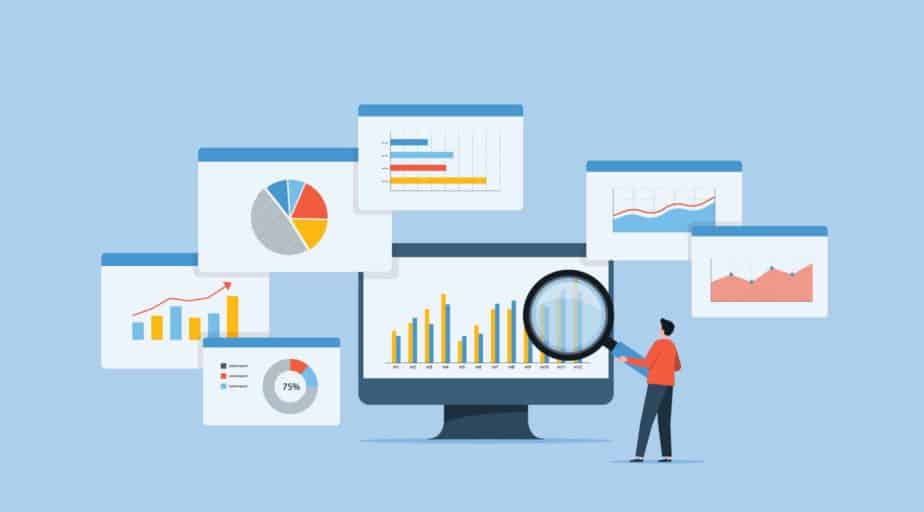Best Practices for Building a Digital Marketing Dashboard
- Justin Reynolds
- February 4, 2020

It’s impossible to overstate the importance of analytics in marketing today. Many businesses already use data on a strategic and tactical level, and more are entering the mix every day.
One McKinsey survey revealed that 50 percent of respondents believe analytics and big data have fundamentally changed business practices in their sales and marketing functions.
That’s not to say that analytics and big data are always easy to implement. Raw data needs to be processed, organized and presented so that end users can understand why digital marketing dashboards are growing in popularity.
Take a look at any marketing department that’s successfully using analytics and big data, and you’re likely to find a robust digital marketing dashboard tying it all together.
What is a Digital Marketing Dashboard?
A digital marketing dashboard is a data reporting tool for unified marketing impact analytics. Think of it like a digital marketing scorecard that teams can use to chart progress and make informed decisions. It can track campaigns across multiple marketing channels and report on custom key performance metrics, among other things.
For example, an enterprise may run multiple simultaneous marketing campaigns that span social media, internet advertising, email, snail-mail, and print—each requiring ongoing analysis and feedback, which can be difficult to track manually.
However, by deploying a digital marketing dashboard, all of these various campaigns come together in a single centralized portal.
Marketing managers use digital marketing dashboards to quickly drill down into specific campaigns and obtain real-time, historical, and predictive analytics.
Best Practices for Building a Marketing Dashboard
Digital marketing dashboards are rarely plug-and-play. Instead, they’re a blend of statistical and reporting techniques often pieced together using multiple big data tools, visualization components, and analytics engines. For the best results, some level of customization will be required.
With that in mind, let’s take a look at some tips to consider when you’re trying to build a great dashboard to guide your marketing efforts.
Track KPIs that matter
Building a useful marketing dashboard requires restraint.
While it’s important to track as much data as possible, that doesn’t mean all your data has to wind up in your dashboard. Often, marketers will try to track too much at once, creating confusing dashboards that distract managers from focusing on what’s important.
Remember that the point of tracking KPIs is to reach and exceed your marketing goals. Before you get started, prioritize your goals and then add specific KPIs to meet your objectives.
Don’t track vanity metrics. Vanity metrics are those that make something look good but may not be tied to business outcomes. If a metric does not drive the prospect to take the desired action, don’t track it.
Some standard marketing dashboard KPIs include Conversion Rates, Cost Per Conversion, Cost Per Lead, Return on Ad Spend (ROAS), and Return on Investment (ROI). Each of these could be broken down by Channel, Campaign, Landing Pages, etc.
Use Marketing Mix Modeling (MMM) to Analyze Your Total Impact
Ultimately, marketing is only useful if it is driving sales.
Marketers often use MMM to estimate how various marketing channels impact sales. Media Mix Models inform what the right mix of spending should be across multiple channels for maximum impact and the level of the expenditure at which each channel hits a point of diminishing returns. This information can be used to guide marketing budgeting decisions. Media mix models are beneficial in multi-channel brand campaigns or non-direct-response campaigns where a collection of various marketing initiatives ladder up to an overarching business objective, most commonly sales.
The primary output of a MMM is Return on Investment (ROI) or Return on Ad Spend (ROAS), which are key metrics to track.
Use Multi-Touch Attribution
Don’t spend any more time agonizing over which channels you should be targeting, like LinkedIn or Facebook. Instead, use a multi-touch attribution model to attribute your conversions to specific channels, campaigns, and even creative assets.
Multi-touch attribution (MTA) considers every marketing touchpoint that a prospect interacts with before converting (such as making a purchase). The right kind of MTA model also determines the incremental impact of a marketing touchpoint on the conversion. For example, it can tell you whether the retargeting ad you ran on Facebook played any role in converting someone exposed to it.
MTA’s key metric is Cost Per Conversion, which can be broken down by channels, campaigns, landing pages, and creative assets.
Effective Visualization is Key
Most people are visual learners, and they respond better to data when presented in organized and colorful graphics that effectively convey the story and action.
Consider using a data visualization tool like Tableau to create compelling visualizations and integrate them into your digital marketing platform. Read our post that compares the two most popular BI Tools out in the market today, Tableau and PowerBI .
Watch Your Data Blind Spots
In one study, 47 percent of respondents said that—when it comes to gaining insights from their marketing data —data silos and accessibility problems are their top challenges.
In other words, information often comes from disparate data sources that do not communicate with one another, leading to gaping marketing holes and incomplete reporting. Ensure you are bridging the silos whenever possible or otherwise aware of the silos so as not to make incorrect decisions based on incomplete data.
No-code Data Transformation Simplifies the Process
Data transformation can be a difficult and complex part of the process when building a digital marketing dashboard. You may have solved the simple EL part of the process through data loader tools that can extract data from sources such as Marketo, Hubspot, Google Analytics, and Adobe Analytics and load it into your Snowflake data cloud. But that’s the simple part. Transforming this large, diverse, and complex set of data into something consumable in your dashboard is the difficult part. At least until now!!!
The Datameer SaaS Data Transformation is the industry’s first collaborative, multi-persona data transformation platform integrated into Snowflake. The easy-to-use, multi-persona UI, with no-code, low-code, and code (SQL) tools, brings together your entire team – data engineers, analytics engineers, analysts, and data scientists – on a single platform to collaboratively transform and model data. Catalog-like data documentation and knowledge sharing facilitate trust in the data and crowd-sourced data governance. Direct integration into Snowflake keeps data secure and lowers costs by leveraging Snowflake’s scalable compute and storage.
Learn more about our innovative data transformation solution, Sign up for your free trial today!


